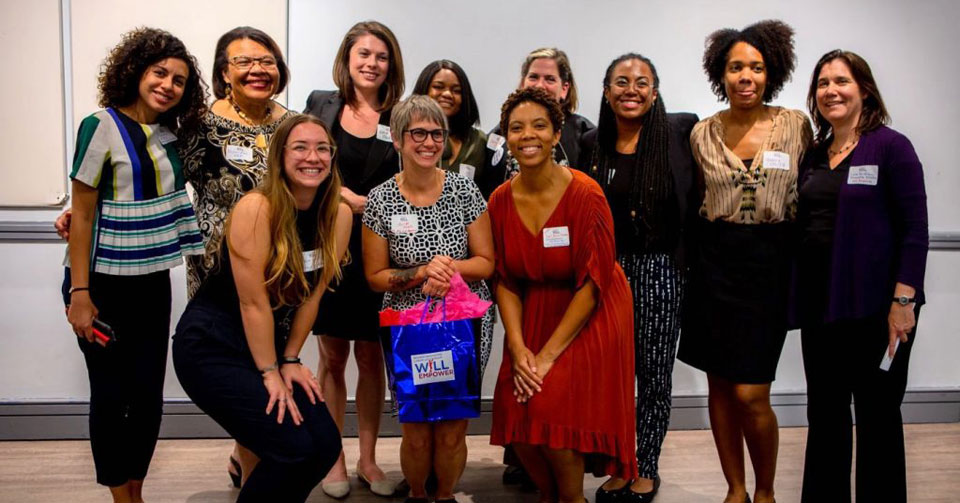
WASHINGTON—Women across America, learning firsthand about the extent to which bosses try to destroy unions, are taking the lead in confronting and battling back against the union busters. At one notorious workplace, the Amazon warehouse in Bessemer, Alabama, they battled union busters who tried all kinds of tactics to defeat the union organizing drive, including harassment following them home at night.
Jennifer Bates, a lead organizer at Amazon’s monstrous Bessemer warehouse, talked about this in a recent discussion. The illegal following of workers to their homes happened in the middle of their second drive to unionize the 5,000-plus workers at Bessemer, the majority of them workers of color, after their union, the Retail, Wholesale and Department Store Union, lost the first election, in 2021, by a two-to-one ratio.
The National Labor Relations Board (NLRB) tossed out that first vote due to rampant company labor law-breaking, officially called unfair labor practices. So RWDSU came back for a rerun, culminating in a second election earlier in 2022, again facing Amazon and its founder and dominant force, Jeff Bezos, one of the richest people in the U.S.
And this time, applying lessons learned in the runup to the first vote, Bates and her RWDSU colleagues undertook intensive education of their co-workers, even as Amazon’s hired union-busters trailed the organizers on their way home and on their house-to-house campaign visits to co-workers.
The union-busters, as usual, also forced workers into “captive audience” meetings, complete with harangues against unions in general and RWDSU in particular. “The anti-union consultants really angered me,” Bates told a recent session on the rising role of women in the union movement, sponsored by Georgetown University in D.C.
“One employee asked them: ‘Why do we see you all only during election time?’”
And when the union-buster stood up and bleated about how unionizing would economically hurt workers, even in low-wage Alabama—starting from zero, if you will—“one anti-union person stood up” in the captive audience meeting “and said, ‘That’s a lie.’
“The point is they”—companies and their “consultants’—“should not be allowed to interfere with our efforts.”
It was incidents like that, plus a lot of one-on-one meetings and education, that produced a win among 600 tech workers at the New York Times, that led to a mail-in election now occurring at a Starbucks in Cleveland, and produced a rerun race too close to call in the second Bessemer vote.
Georgetown’s Women Innovating Labor Leadership initiative brought Bates, Times senior software engineer Nozlee Samadzeh and Cleveland Starbucks worker Maddy Van Hoek together for the zoom discussion on the rising role of women in the labor movement. Instead, the session ranged far afield.
One big point all three agreed upon: While almost half the U.S. workforce is female, and while women are discriminated against on the job in pay, benefits and promotions, most women—and most workers—know little if anything about unions, and how organizing can help them improve their lot and lessen pay and benefit inequality.
“Doing basic agitating about working conditions can make you a lot more familiar” with people’s individual problems on the job—and how they’re all similar—said Samadzeh, in a statement Bates agreed with. “Workplaces are built for people not to unionize…We understand we’re all workers and can improve conditions by having a (union) contract.”

“We thought it would be easy” to organize Bessemer, “because a lot of people understood what a union was,” Bates added. They didn’t and it wasn’t. “They should begin teaching about labor education in middle school–and have it be a requirement, not an elective, in college.
“So the second time around” at Bessemer “we did a lot more education.”
That education involved a lot more one-on-one communication. At Bessemer, it was door-to-door, in the parking lot after shift changes, in break rooms and house to house. For the Times workers, all in its tech arm, it was the web.
“The Internet makes it so much easier to be in contact” with co-workers “and to meet people where they are at,” said Samadzeh (her emphasis). It also helped counteract past sketchy knowledge of unions as white-male dominated “and something your grandfathers did,” one of the three added.
Again, an internal company decision set the organizing drive off. At the Times, it was “a homophobic op-ed” the paper published, which left the staffers at the tech arm irate. They began looking for an united way to express their outrage. “And a number of people had been advocating for gender-neutral restrooms,” too.
The New York News Guild, which has had wall-to-wall representation in the paper’s newsroom for decades, was the answer.
Personal stories about how unions helped, too. Samadzeh had her own, from the shop she worked at before joining the Times, Watts Media Productions in Manhattan.
“The company abruptly moved to pay us in arrears,” meaning after a pay period ended. And sometimes the checks were late. “There was a two-week period where no one got paid and everybody was freaking out.” Unionizing was the staff’s answer.
At Starbucks, said Van Hoek, it was the realization the impression the firm gave “that it’s a decent place to work,” isn’t altogether true. “A lot of people in the community said ‘I thought you were treated well.’ But even if Starbucks did live up to its standards, we could still form a union, for accountability.”










